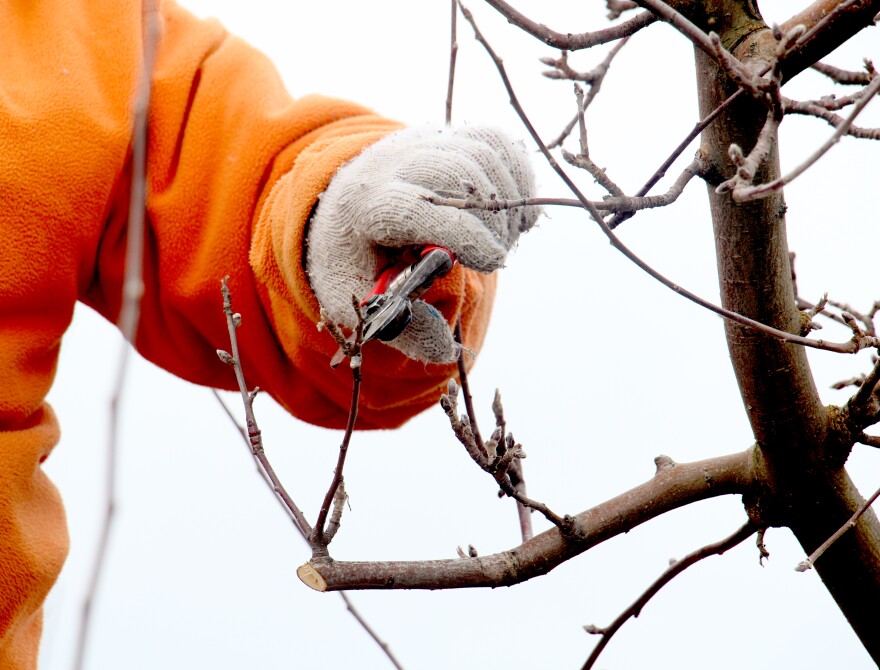We are all in this new world together, with more indoor time spent navigating every sort of work-from-home-slash-kids-schooling-from-home scenario you can conjure. Still, it's good to take time away, if only for a bit, from important news of the day. So this week, gardening expert Charlie Nardozzi shares some early spring gardening projects. And there are a lot!
Pruning
Now is a good time to prune fruit trees like grapes, blueberries and some ornamental shrubs. (Hydrangeas can wait 'til next week, though!).
For now, prune off suckers, water sprouts and dead, diseased and broken branches. Open up fruit trees by removing crowded branches and those rubbing each other. It's safe to prune off 70% of the grape canes, leaving short branches of 1-year-old growth on each arm that will fruit this year.
If your blueberries are younger than 5-years-old, hold off on those. Older blueberry bushes are fair game, and you can just remove the oldest canes (ones with grey bark) that aren't growing very strongly. You should have some young, middle-aged, and older branches to keep the fruit coming for years.
Force flowering branches
To get a little taste of spring indoors, take some of the branches from trees and shrubs you pruned and force them into flower indoors. Select branches from forsythia, apple, cherry, lilac, and flowering quince with fat buds on them. These are usually the flower buds. Place them in a vase of warm water in a warm, bright room.In a week or so, you'll start to see some flowers.
Spray deciduous trees
Now is a good time to spray horticultural oil on deciduous trees and shrubs to smother overwintering insects. Fruits trees, roses, magnolias, lilacs and many other shrubs will benefit from this safe spray. Apply the spray on calm days, when the temperatures are above 40 degrees, but before the buds start to open.
Protect bulbs from critters
Tulips and spring flowering bulbs might be up, and so are the deer and rabbits eating the foliage! Sprinkle or spray an animal repellent, such as Plant Skydd, on the foliage to deter them. Plant Skydd is made from dried blood and is very effective. Be aware that dogs like it too, so you might have to cover the bulbs for a few days until the smell dissipates. You can also use wire mesh covers to protect the bulbs.
Move late-flowering perennials
As perennials start to show their shoots, identify which ones are coming up and, if you have to, dig and transplant late-flowering ones, such as rudbeckia and asters, now. Don't touch spring-flowering perennials for risk of reducing their flowering.
Make raised beds
Consider re-doing or making raised beds to grow veggies and flowers in this year. In weedy areas, or if you don't want to bend over as much, build 3-foot-tall beds filled with a mix of topsoil and compost or with a false bottom one foot below the top. Charlie has a webinar coming up on April 9 on Raised Bed Gardening for ideas and inspirations.
Some gardening projects to hold off for now
Don't start tomatoes indoors yet. It's better to start them April 1st and have small, fast-growing seedlings versus ones that are too big for their space.
Also, don't clean up your perennial garden yet. Many beneficial insects may be overwintering in the leaf and plant layer. Wait until we get a week of days above 50 degrees, so as not to disturb them.
Another no-no is to avoid walking around on wet ground, like spongy wet lawns or beds. Walking will compress the soil, making for fewer air spaces and compacting the soil around the roots. Wait until it dries out a bit first.

All Things Gardening is powered by you, the listener! Send your gardening questions and conundrums and Charlie may answer them in upcoming episodes. You can also leave a voicemail with your gardening question by calling VPR at (802) 655-9451.
Hear All Things Gardening during Weekend Edition with VPR host Mary Engisch, Sunday mornings at 9:35.






